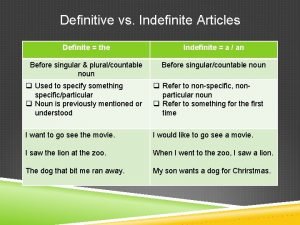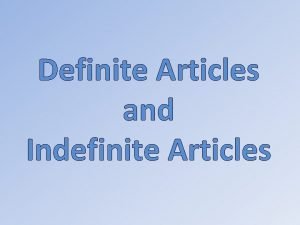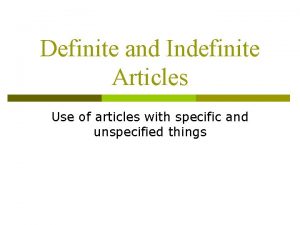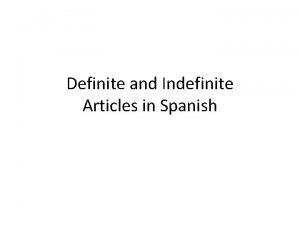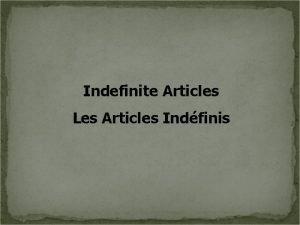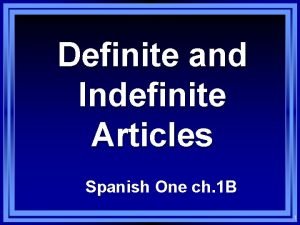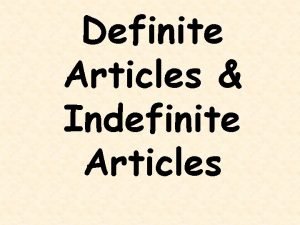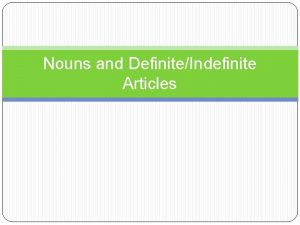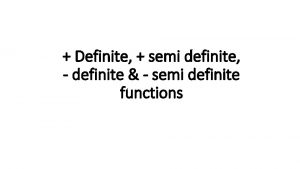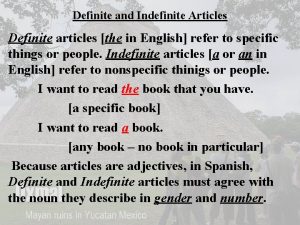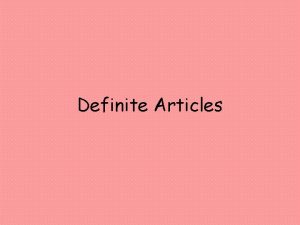Definite and Indefinite Articles Use of articles with









- Slides: 9

Definite and Indefinite Articles Use of articles with specific and unspecified things

Definite articles p p All nouns in Spanish are masculine or feminine. In Spanish, the definite article (the) that accompanies a noun will match its gender and number. Definite article Noun Singular El (the) Chico (boy) Plural masculine Los (the) Chicos (boys) Singular feminine La (the) Chica (girl) Plural feminine Las (the) Chicas (girls) masculine

Definite articles (continued) p Son para el concurso. n p El matches concurso. A los nuevos amigos. n Los matches amigos. The gender of a noun must be learned. p Usually p n n Nouns ending with –o are masculine Nouns ending with –a are feminine.

Indefinite articles p p Indefinite Noun A noun may article sometimes appear with an indefinite Singular Un Chico article (a, an or masculine (a) (boy) some). Unos Chicos The indefinite article Plural masculine (some) (boys) that accompanies a noun will also match Singular Una Chica its gender and number. feminine (a) (girl) Plural feminine Unas (some) Chicas (girls)

Modelos p El sombrero es rojo. n p La blusa es azul. n p A shirt is good. Un chico es un estudiante. n p The blouse is blue Una camisa es buena. n p The hat is red A boy is a student. Unas camisetas son marrónes. n Some T-shirts are brown.

Sustantivos y adjetivos plurales p To make nouns and adjectives plural in Spanish, you will either add -s or –es. p The last letter of the singular nouns or the correct gender form of the adjective determines what you add to make plural

Add an -es If the singular form ends with a vowel that has an accent mark. p If the singular form ends with any consonant p por ejemplo: rubí azul pared canción rubíes azules paredes canciones

Add an -s p If the singular form ends with a vowel with no accent mark. por ejemplo: gato chica buena verde gatos chicas buenas verdes

There are some spelling changes to keep in mind! p Change a –z to a –c before adding –es n Por ejemplo: Pez p Lápiz peces p p lápices Most words that have an accent mark will drop the accent mark when plural. n Por ejemplo: Canción p Sillón p canciones sillones
 Definite vs indefinite article
Definite vs indefinite article Indefinite and definite articles in spanish
Indefinite and definite articles in spanish Definite and indefinite nouns
Definite and indefinite nouns Definite article in spanish
Definite article in spanish Indefinite articles in spanish examples
Indefinite articles in spanish examples Definite and indefinite articles spanish
Definite and indefinite articles spanish Italian definite and indefinite articles chart
Italian definite and indefinite articles chart Chico indefinite article
Chico indefinite article Indefinite articles in spanish
Indefinite articles in spanish Definite article spanish
Definite article spanish
